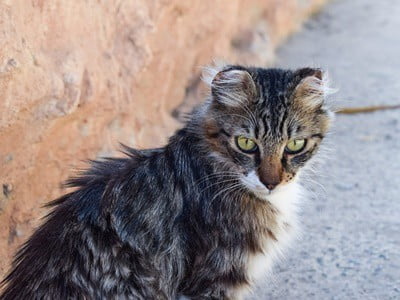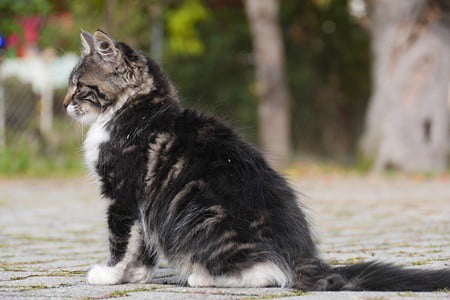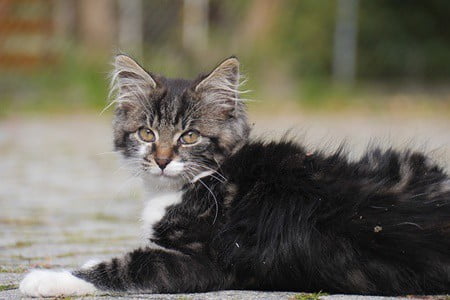Healthy cats spend many hours licking and biting at their fur to remove dirt and debris. So, if a cat’s coat is greasy and clumping up, something is wrong. Health concerns, either physical or emotional, will be behind the problem.
An obese or arthritic cat will be physically incapable of grooming, leading to greasy and clumpy fur. Dental pain will also leave a cat unwilling to groom itself. Medical explanations include hyperthyroidism, diabetes, and skin conditions. Also, a lack of self-grooming can be an early symptom of cognitive dysfunction.
An unkempt coat will be unsettling for your cat, so you should assist with its daily grooming. You’ll also need to find out why your cat has oily and clumpy fur so that action can be taken to resolve the issue.
Why Is My Cat’s Hair Oily And Clumping Together?
The natural oils cause greasy and clumpy fur in a cat’s coat. When a cat grooms, it redistributes these oils evenly throughout its fur. This is how cats retain a sleek, elegant appearance.
Cats spend up to 50% of their day grooming. Cats groom to retain a neutral scent, which is an instinctive survival behavior. It means that potential predators will not be able to smell a cat, appealing to a cat’s survival instincts.
If a cat has stopped grooming, check that it is still physically capable of doing so. Even senior cats do not stop grooming by default. A lack of grooming is often a case of cannot, rather than will not.
Obesity
As cats grow older, they naturally become less active. Play is less appealing, and cats are less interested in exploring the wilderness and scaling trees. Cats prefer to find a quiet corner and sleep away the day.
This is all part of the aging process, but your senior cat’s BMI must be monitored. If your cat moves less but consumes the same number of calories, weight gain is inevitable.
You will need to moderate a cat’s caloric intake or promote weight loss. Obesity places pressure on a cat’s heart and joints. In addition, feline diabetes becomes an enhanced risk. The Journal of Feline Medicine and Surgery considers senior male cats the highest risk group for diabetes.
Any overweight cat can develop diabetes. It leads to fluctuations in hormones within a cat’s body, leading to greasy, clumped-up fur. Even if your cat is not diabetic, excessive weight will affect its ability to groom. Grooming is a cardio workout for cats. An overweight cat will quickly grow exhausted and give up.
An overweight cat may also be physically incapable of accessing certain parts of its body. Healthy cats are agile, able to contort their bodies into a range of positions. Excess body fat makes this impossible, so hard-to-reach spots of a cat’s fur will become greasy and clumpy.
Arthritis and Joint Pain
Senior cats are at risk of developing osteoarthritis. This stiffness will leave a cat unwilling or unable to groom. The Journal of the American Veterinary Medical Association found arthritis symptoms in 90% of cats aged 12 or older.
You may not immediately notice that your cat is arthritic. Cats are good at hiding their discomfort. If a cat is incapable of walking without limping, it will opt not to move. Showing outward signs of distress is seen as weakness by cats.
Limping and lameness are also not the most common symptoms of arthritis. The Journal of Small Animal Practice explains that jumping is the first activity to suffer. If your cat no longer leaps to and from the sofa and has greasy fur, arthritis is likely to blame.
Arthritis can’t be prevented. Cats endure pressure on their joints while young and active. This eventually takes its toll on the body once collagen production slows down, so be sure to manage your cat’s arthritis pain.
Massage your cat’s joints and give them beneficial supplements. Provide a soft, warm bed for your cat to relax in and encourage your cat to keep moving.

Dental Pain
If a cat is experiencing dental pain, it will be reluctant to groom. Grooming is as painful as eating for a cat with dental issues. A cat with dental problems will present with the following symptoms, as well as refusing to groom:
- Reluctance to eat or drink
- Stained and discolored teeth
- Pawing at the mouth
- Swelling around the mouth
- Black gums
- Foul breath
Take action at the first sign of dental pain, as gum disease will cause the problem. If you treat the condition (gingivitis) early, it can sometimes be reversed.
Left untreated, gingivitis leads to periodontal disease. This will be a steady degradation of your cat’s teeth that cannot be cured. The best that you’ll be able to achieve at this stage is pain management. A cat with periodontal disease will experience regular flare-ups, so grooming the fur will cease.
Depression
If your cat is withdrawn and refusing to eat, depression is likely. Depressed cats lose all interest in grooming themselves. Reasons for a cat to become depressed include:
- Major lifestyle changes
- Missing a former owner or fellow cat
- Chronic pain
- Boredom
- Loneliness
Do not wait for your cat’s depression to pass, as there’s no way of knowing how long this will take. Enhance your cat’s lifestyle with a range of stimuli and ensure that it follows a steady routine.
Skin Conditions
Cats can get fungal infections of the skin that damage the fur, such as ringworm and seborrhea. Fungal conditions are most common in outdoor cats. When a cat roams outside, it may encounter other infected felines.
Seborrhea
Also known as seborrheic dermatitis, seborrhea comes in two forms.
Seborrhea sicca leads to dry, flaky skin. Seborrhea oleosa leads to oily, greasy skin. Many cats experience both kinds of seborrhea simultaneously. Along with greasy fur, cats with seborrhea have dandruff.
Seborrhea is sometimes hereditary. It can also take be a secondary condition, alongside another illness. Treating the primary cause of seborrhea will usually clear up the condition. You can only manage the issue with topical steroids.
Ringworm
Ringworm is a highly contagious fungal infection. Ringworm causes spherical, dry, and flaky rings on the cat’s skin. These are caused by inflammation.
The fungi that cause ringworm symptoms are known as dermatophytes. These fungi feed on the keratin found within a cat’s fur. This causes the fur to become discolored and greasy. Before long, the hair may fall out in clumps.
Ringworm will resolve itself in time, but it is contagious to cats and humans alike. This means that treatment will be necessary. A vet will diagnose oral antifungal medication and a specialist shampoo.
Parasitic Infestations
Congregations of fleas and mites will adversely affect your cat’s fur. These parasites attach themselves to a cat’s skin, causing irritation. The cat will bite and scratch at the fur near-constantly, attempting to relieve this itching. This will damage the appearance of fur.
Unfortunately, preventative treatments can also cause greasy and clumping fur. This will be due to the chemicals released by the remedy. The issue will usually be confined to the shoulders, where the treatment is administered. Switch to a different brand if this occurs.
Parasites can also lead to secondary health concerns. Seborrhea can be caused by flea bites, as well as allergic reactions. This is one of the reasons why it is critical to find a suitable preventative treatment.
Hyperthyroidism
The risk of hyperthyroidism increases as cats grow older. Hyperthyroidism is a glandular disorder. The thyroid gland is located in the back of a cat’s throat. This produces a hormone called thyroxine-a, aka T4.
If your cat is living with hyperthyroidism, thyroxine-a will flood the body. As this hormone is linked to a cat’s metabolism, an excess will cause a range of side effects. These include:
- Sudden and inexplicable weight loss
- Increased thirst
- Bursts of hyperactive energy
- Panting
- Diarrhea
These symptoms can be confused with other ailments. This is why you should pay attention to greasy or oily fur, which is the first sign of hyperthyroidism. If a diagnosis of hyperthyroidism is made, your cat will need lifelong oral medication.
Hyperthyroidism itself is not fatal. According to the Canadian Journal of Veterinary Research, hyperthyroidism can lead to renal failure. Your cat’s thyroid levels must be regularly monitored.

Poor Diet
A cat that lacks appropriate nutrition in its diet will experience poor-quality fur. If your cat’s fur is oily or clumping, check the nutritional value of its food. Common issues include:
- Insufficient or low-quality protein
- Insufficient or low-quality fats
- Food prepared or served at high heat
- Excessive carbohydrate content
Age-appropriate food becomes increasingly important when a cat grows older. Senior cats have different nutritional needs. Maintain high-quality protein and keep carbohydrates to a minimum. As obligate carnivores, carbohydrates serve no nutritional purpose to a cat.
Wherever possible, prioritize wet food for a senior cat. Dry foods are lacking in amino acids, as these are found in protein and animal fats. Amino acids are building blocks of hair follicles in cats.
Cognitive Dysfunction
A senior cat may be struggling with its mental faculties. Behaviors dismissed as just ‘old age’ are now universally recognized as symptoms of cognitive dysfunction. This form of feline senility starts to manifest from age 10. Cats aged 15 or older may experience a sharp uptake in symptoms.
As explained by Topics in Companion Animal Medicine, feline cognitive dysfunction often presents itself alongside other conditions. The most common symptoms are missing the litter box and yowling loudly at night.
If your cat has cognitive dysfunction, it will live in a state of regular confusion. The cat will forget basic tasks, including grooming. You will need to lend a hand to your cat. Actively groom with a comb and brush.
Feline cognitive dysfunction isn’t curable, but its progression can be slowed down. Engage with your cat regularly. The more your senior uses its critical faculties, the more it’s likely to remember. Play and puzzle games can be beneficial.
Never write off greasy and clumpy fur as just a cat being lazy. Even the most sedate cat will wish to retain a clean scent and appearance. There will be a reason for a lack of grooming in cats.

